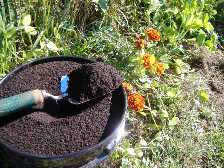Synthetic vs. Organic Fertilizers
by Jerry Gach
Organic Fertilizers are materials derived from plant and animal parts or residues. Examples are, Blood Meal, Compost, Bat Guano, Manure, Seaweed, and Worm Castings.
Synthetic Fertilizers are “Man made” inorganic compounds - usually derived from by-products of the petroleum industry. Examples are Ammonium Nitrate, Ammonium Phosphate, Superphosphate, and Potassium Sulfate.
Plants require 13 nutrients. There are three primary macronutrients; nitrogen (N), phosphorus (P), and potassium (K). These nutrients are used in significant amounts by growing plants, so they must be replaced periodically to sustain productivity.
The secondary nutrients are; calcium (Ca), magnesium (Mg), and sulfur (S). There are usually enough of these nutrients in the soil, so additional fertilization is not always needed. The micronutrients used in small quantities are; boron (B), copper (Cu), iron (Fe), chloride (Cl), manganese (Mn), molybdenum (Mo) and zinc (Zn).
Plants cannot distinguish between an organic or synthetic fertilizer – the nutrients are processed in exactly the same way. However, the similarity stops there.
Chemical fertilizers add nutrients to the soil, but they don’t add anything else. Plants needs more than just nutrients to survive. They also need organic matter and living organisms. Synthetic fertilizers do not support microbiological life in the soil. The application of a synthetic fertilizer actually kills a significant percentage of beneficial microorganisms. These tiny creatures are responsible for breaking down organic matter into a stable amendment for improving soil quality and fertility. Some convert nitrogen from the air into a plant useable form.
 Compost and organic material introduces beneficial microorganisms. Microorganisms commonly found in soil and compost convert organic nitrogen into inorganic nitrogen, a process called mineralization. Plants may then take up the nutrients released by these. Composts contain an astonishing variety of microbes, many of which may be beneficial in controlling pathogens. Beneficial microbes help to control plant pathogens.
Compost and organic material introduces beneficial microorganisms. Microorganisms commonly found in soil and compost convert organic nitrogen into inorganic nitrogen, a process called mineralization. Plants may then take up the nutrients released by these. Composts contain an astonishing variety of microbes, many of which may be beneficial in controlling pathogens. Beneficial microbes help to control plant pathogens.
- Organic matter improves soil structure, resulting in a crumb-like structure.
- Organic matter improves water retention and enhances soil fertility.
- Microorganisms can break down contaminants in the soil and water to components that pose less of an environmental hazard.
There are some disadvantages in using organic fertilizers, but the benefits outweigh the limitations. Limitations of organic amendments:
- The composition of organic fertilizers may be highly variable.
- Organic materials are a dilute source of nutrients compared to inorganic fertilizers. ·
- Organic fertilizers may be cost prohibitive on a large scale operation.
- Organic fertilizers can be messy, and may require more work to apply.
- The release of nutrients is highly variable, and reflects the number and work of microbiological activity, which generally rises and falls with soil temperature.
Limitations of chemical fertilizers:
- Most chemical fertilizers do not contain micronutrients.
- Synthetic fertilizers do not support microbiological life in the soil.
- Chemicals fertilizers do not add organic content to the soil.
- Synthetic chemicals can easily be over applied, and can "burn" roots, or create toxic concentration of salts.
- Chemical fertilizers can release nutrients too quickly, creating a great deal of top growth before the roots are able to catch up. This kind of growth often leads to weaker and disease prone plants, with less fruiting.
- Synthetic fertilizers often leach, because they dissolve easily, and release nutrients faster than plants use them.
plants require healthy soil!
Alan Hanson and Jerry Gach are the owners of Blue Ridge Vermiculture
